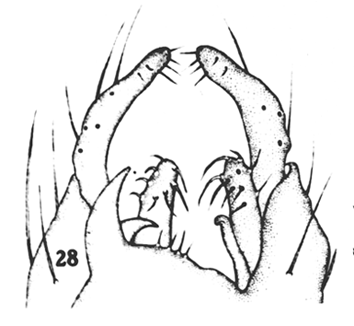Chironomus costatus Johannsen 1932This species as recognized by Karunakaran (1966, 1969) is almost certainly a synonym of Chironomus circumdatus Kieffer 1916 - but see notes under Larva. Adult Head pale yellow, including proboscis and palpi; scape deeper yellow, flagellum brownish; eyes deeply emarginate, narrowly separated on the front; frontal tubercles well developed; twelfth antennal segment over three times as long as segments 2-11 combined. Thorax pale yellow; mesonotum with three deep yellow vittae each margined on both sides with brown, making it appear as if there were six short narrow brown vittae, the lateral pairs connected on the front margin; metanotum deep yellow with two closely approximated brown spots; pleura with a brown spot below wing; sternum deeper yellow; scutellum pale. Abdomen pale yellow, perhaps greenish in life; each tergite with a large, brown, transverse, oval spot which does not touch the incisures. Abdominal tergites with a large brown transverse oval spot, which does not touch the incisures. Legs yellow; extreme tips of fore femora, immediate bases of fore tibiae, and the extreme tips of tarsal segments 1-4 and whole of 5 of mid and hind legs, brown. Anterior leg proportions: 45 : 37 : 64 : 33 : 30 : 26 : 13 (i.e. Ta5/Ti about 0.31); fore tibia with rounded scale; middle and hind tibiae each with two spurs on the usual combs; empodium long, pulvilli large; fore tarsi not bearded. Wings hyaline, veins pale, crossvein faintly tinged with brown; costa not produced, ending slightly farther in front of wing tip than the media does behind it; cubitus forks under the crossvein. Squama fringed. Halteres pale.  Male hypopygium of C. costatus from Johannsen 1932. Hypopygium yellow, dististyles slender, gradually tapering, with some short stiff, inwardly directed bristles near apex; inferior appendages with the usual curved bristles; superior appendages bare, curved, pointed, reaching the base of the spur of the ninth tergite, the spur extendind almost as far caudad as the tip of the inferior appendage. Abdominal tergites with brown transverse fasciae which do not reach incisures. Basal third of fore tibiae and tips of all femora dark brown. Anntennae six-segmented, second compound; sixth segment brown, twice as long as the fifth, intermediate segments flask-shape, the neck about as long as the bulbous part. Similar to male, but body stouter, markings darker and abdominal fasciae very broad covering almost the entire tergites. Pupa: Lenz (1937) describes the pupa as "thummi-type". Larva: There is no larval description from the type locality, but Lenz (1937) describes 4 larval types for this species (see below), three of which are plumosus-type, of length 10-13 mm, with ventral tubules either long or not very long. The fourth type is a thummi-type with long ventral tubules and moderately long anal tubules which are swollen at the base. Cytology: (from unillustrated description by Alfred & Michael, 1990): Found: Type locality - Buitenzorg, BOGOR, INDONESIA; Also Malang and Ngebel. Lenz (1937) describes six immature types for this species: Since Johannsen notes variation in coloration of the adults and Lenz ascribes a number of different larval types to this species, it raises the possibility that more than one species is included under this name. In the absence of a good adult description of material from other countries, it remains uncertain whether those reports relate to the same species, and whether C. costatus or one of the variants is a synonym of C. circumdatus. |
Modified: 31 January 2022
Access: Unrestricted
Copyright © 2010-2022, Jon Martin.